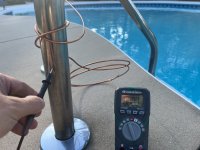I just turned the breakers back on- and measured the handrails again
without the wire running into the water between the handrails (pics right above) - I am getting about 4 - 4.2 volts on both handrails.
When I add the wire and hang it in the water- the bonding wire in the water seems to make a big difference
The handrails to the water then measure in the 0.1 or under range.
It has to be a bonding issue -I can only assume in the handrail area- but maybe along the coping on the side because I still register in the range of .235 on the side about 6 feet from the handrails (on both sides of the pool).
without the wire running into the water between the handrails (pics right above) - I am getting about 4 - 4.2 volts on both handrails.
When I add the wire and hang it in the water- the bonding wire in the water seems to make a big difference
The handrails to the water then measure in the 0.1 or under range.
It has to be a bonding issue -I can only assume in the handrail area- but maybe along the coping on the side because I still register in the range of .235 on the side about 6 feet from the handrails (on both sides of the pool).






